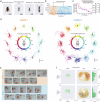Switching escape strategies in the parasitic ant cricket Myrmecophilus tetramorii
- PMID: 39739101
- PMCID: PMC11686385
- DOI: 10.1038/s42003-024-07368-y
Switching escape strategies in the parasitic ant cricket Myrmecophilus tetramorii
Abstract
Social parasites employ diverse strategies to deceive and infiltrate their hosts in order to benefit from stable resources. Although escape behaviours are considered an important part of these multipronged strategies, little is known about the repertoire of potential escape behaviours and how they facilitate integration into the host colony. Here, we investigated the escape strategies of the parasitic ant cricket Myrmecophilus tetramorii Ichikawa (Orthoptera: Myrmecophilidae) toward its host and non-host ant workers. We identified two escape strategies with distinct trajectory characteristics by clustering analysis; distancing (defined by high-speed straight movement away from ants for emergency avoidance) and dodging (circular escape movement to get behind ants under low-threat conditions). Interestingly, dodging is dominantly elicited over distancing for host species. Furthermore, our simulations proposed that dodging contributes to efficient foraging while avoiding ants. These results demonstrate that switching to a host-adapted escape strategy facilitates integration of this parasitic cricket into ant nests.
© 2024. The Author(s).
Conflict of interest statement
Competing interests: The authors declare no competing interests.
Figures





Similar articles
-
First record of the ant cricket Myrmecophilus (Myrmecophilina) americanus (Orthoptera: Myrmecophilidae) in Mexico.Zootaxa. 2017 Apr 27;4258(2):195-200. doi: 10.11646/zootaxa.4258.2.9. Zootaxa. 2017. PMID: 28609930
-
Taxonomic recovery of the ant cricket Myrmecophilus albicinctus from M. americanus (Orthoptera, Myrmecophilidae).Zookeys. 2016 May 16;(589):97-106. doi: 10.3897/zookeys.589.7739. eCollection 2016. Zookeys. 2016. PMID: 27408536 Free PMC article.
-
Behavioral strategies of phorid parasitoids and responses of their hosts, the leaf-cutting ants.J Insect Sci. 2012;12:135. doi: 10.1673/031.012.13501. J Insect Sci. 2012. PMID: 23448343 Free PMC article.
-
Foe to frenemy: predacious ant nest beetles use multiple strategies to fully integrate into ant nests.Curr Opin Insect Sci. 2022 Aug;52:100921. doi: 10.1016/j.cois.2022.100921. Epub 2022 Apr 4. Curr Opin Insect Sci. 2022. PMID: 35390506 Review.
-
The coevolutionary dynamics of obligate ant social parasite systems--between prudence and antagonism.Biol Rev Camb Philos Soc. 2005 May;80(2):251-67. doi: 10.1017/s1464793104006669. Biol Rev Camb Philos Soc. 2005. PMID: 15921051 Review.
References
-
- Kronauer, D. J. C. & Pierce, N. E. Myrmecophiles. Curr. Biol.21, 208–209 (2011). - PubMed
-
- Lachaud, J. P., Lenoir, A. & Witte, V. Ants and their parasites. Psyche2012, 1–5 (2012).
-
- Parmentier, T. Guests of Social Insects. Encycl. Soc. Insects 1–15 (2020).
-
- Sturgis, S. J. & Gordon, D. M. Nestmate recognition in ants (Hymenoptera: Formicidae): A review. Myrmecological N.16, 101–110 (2012).
MeSH terms
Supplementary concepts
Grants and funding
LinkOut - more resources
Full Text Sources

